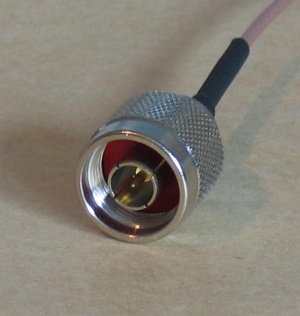Difference between revisions of "Konektor N"
Onnowpurbo (talk | contribs) (New page: thumbnail|Type N connector (male) thumbnail|Type N connector (female) [[Image:PICT7394 trimmed N.jpg|thumbnail|Picture to show th...) |
Onnowpurbo (talk | contribs) |
||
| Line 1: | Line 1: | ||
| − | [[Image:N-Connector. | + | [[Image:N-Connector.jpg|thumbnail|Type N connector (male)]] |
[[Image:N connector female.jpg|thumbnail|Type N connector (female)]] | [[Image:N connector female.jpg|thumbnail|Type N connector (female)]] | ||
| − | |||
| − | |||
The '''N connector''' (in full, '''Type N connector''') is a threaded [[RF connector]] used to join [[coaxial cables]]. It was one of the first connectors capable of carrying [[microwave]]-frequency signals, and was invented in the 1940s by [[Paul Neill]] of [[Bell Labs]], after whom the connector is named. | The '''N connector''' (in full, '''Type N connector''') is a threaded [[RF connector]] used to join [[coaxial cables]]. It was one of the first connectors capable of carrying [[microwave]]-frequency signals, and was invented in the 1940s by [[Paul Neill]] of [[Bell Labs]], after whom the connector is named. | ||
Latest revision as of 14:53, 26 January 2010
The N connector (in full, Type N connector) is a threaded RF connector used to join coaxial cables. It was one of the first connectors capable of carrying microwave-frequency signals, and was invented in the 1940s by Paul Neill of Bell Labs, after whom the connector is named.
Design
Originally, the connector was designed to carry signals of up to 1 GHz in military applications, but the common Type N today handles up to 11 GHz comfortably. More recent precision enhancements to the design by Julius Botka at Hewlett Packard have scaled this to 18 GHz. The male connector is hand-tightened and has an air gap between center and outer conductors. The coupling has a 5/8-24 thread.
Usage
The N connector follows the MIL-C-39012 standard, defined by the US military, and comes in 50 and 75 ohm versions. The 50 ohm version is widely used in the infrastructure of land mobile, wireless data, paging and cellular systems. The 75 ohm version is primarily used in the infrastructure of cable television systems. Connecting these two different types of connectors to each other can lead to damage due to the difference in diameter of the center pin. Unfortunately, many type N connectors are not labeled, and it can be difficult to prevent this situation in a mixed impedance environment.
The 50 ohm type N connector is favored by enthusiasts who create their own Wireless LAN antenna systems, which run at 2.4 GHz or 5 GHz. The Cantenna is one such design. The enthusiasts have settled on using the N connector as a standard connection for homebrew antennas. By using a cable with an N connector one can easily interchange homebrew antennas. 50Ω N connectors are also commonly used on amateur radio devices (e.g., transceivers) operating in UHF bands.
Variations
SnapN was originally designed by Rosenberger Hochfrequenztechnik in 2006 and is a quick locking replacement for the threaded interface of the widely applied Type N connector. Though part of the Quick Lock Formula Alliance (QLF), engineers at Rosenberger independently designed the SnapN in order to correct the performance issues of QLF’s version of the quick lock N connector, QN. This design achieves better electronic performance because, unlike the QN, this new version maintains the basic structural parameters of the original Type N in which the inner dimensions of the outer conductor are 7.00 mm, and the inner conductor’s outer dimensions are 3.04 mm.
See also
External links
- http://www.amphenolrf.com/products/typen.asp Amphenol Type N Connector Series
- http://ece-www.colorado.edu/~kuester/Coax/connchart.htm Coaxial Connectors
- http://www.cmpter.com/n-connecotrs.htm Type N connectors

